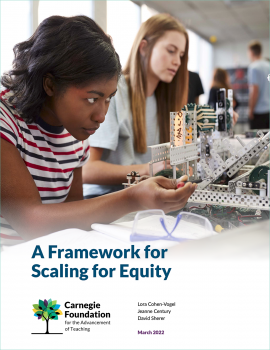A Framework for Scaling for Equity
For more than four decades, researchers, policymakers, professional educators, and the philanthropic community in education have wrestled with how to scale up promising pockets of reform. Twenty years ago, the concept of scale was often used in education to refer to the number of schools or classrooms reached by a given reform effort, but since that time our common conception of scale has evolved. Now, we believe that—to achieve scale—innovations, in education or elsewhere, must do more than simply spread to more users; they must also affect deep change in practice, be sustained over time, cultivate a shared sense of ownership among local community members, and involve fundamental systems change.
Despite this progress in our thinking, by and large, prior work on scaling has given little explicit attention to equity. In this report, however, scaling questions are considered equity questions: What should we scale? Who should be involved? Where and when should we start? How will we know when scale has been achieved?
Centering equity in scaling efforts means working with and prioritizing students who have historically lacked access to powerful learning opportunities, including deeper learning, and have not reached the ambitious outcomes we desire for everyone. This report seeks to help school district leaders and improvement teams define what it means to scale for equity. Presented here is a scaling-for-equity framework informed by the experiences of 10 research-practice partnerships (RPPs) and designed to provide readers with multiple, iterative opportunities to think about equity as it relates to scale.
The scaling-for-equity framework supports a journey in which members of a team work to improve educational practice by traveling over time from their origin to a destination. In doing so, they confront various challenges—some predictable, others less so—that require them to reflect, adapt, and, at times, change course. Using this metaphor, the framework consists of three components that together help improvement teams identify and adapt their scaling efforts along their journey—scaling intentions, scaling strategies, and influential factors.
The framework and accompanying tools are designed to (1) help improvement teams navigate their scaling-for-equity journey and (2) support school district leaders striving to transform their communities’ public education systems into equitable ones by:
- Prompting improvement team members to consider equity-related questions during all stages of the work and to develop shared responses
- Describing and categorizing scaling strategies so that teams can identify the strategies, alone or in combination, that will bring them closer to their equity goals
- Providing support for disentangling and addressing the many influences and tensions at play when improvement teams aim to bring about change





